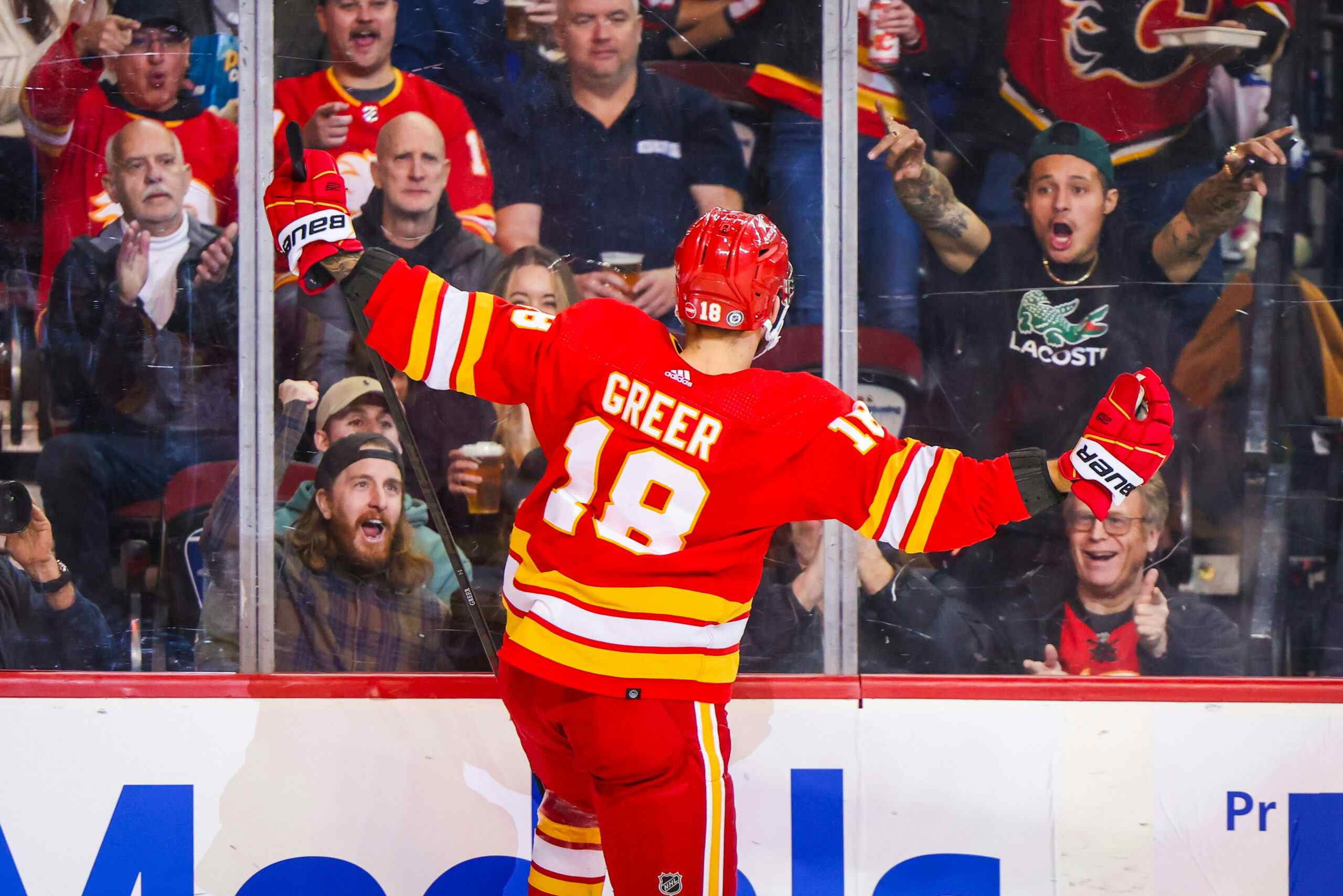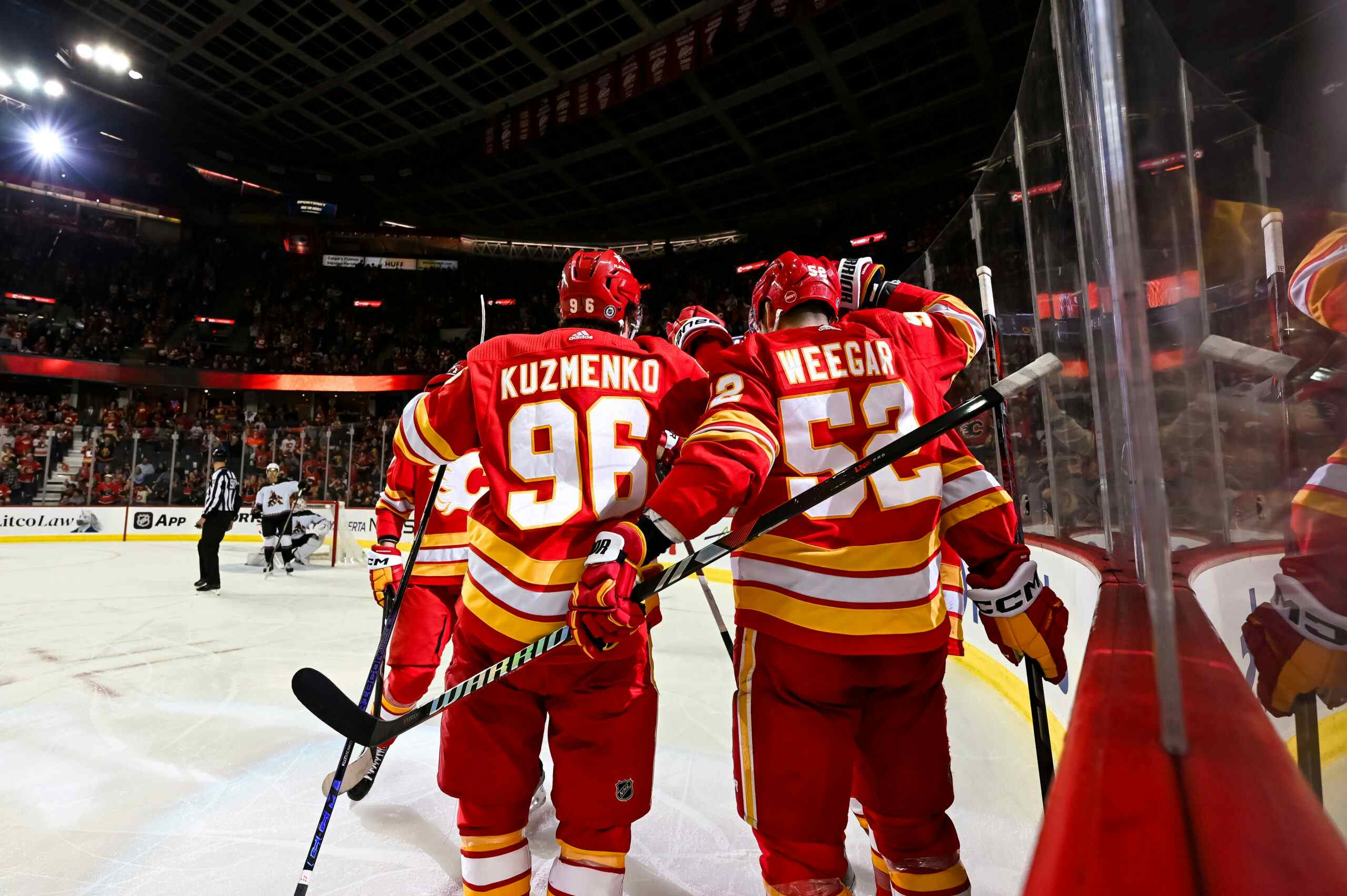Flames 2011-12 Player Grades: Goaltending

After Kent broke down the end-of-season grades for the Top Six and Support Forwards, I turned the attention to the Defense. Last but not least, we take a look at the Calgary Flames last line of defense, the goal-tending.
Calgary’s goal-tending has always been a bone of contention – how do the Flames get some help so that Kiprusoff isn’t playing 70 games every season, especially now that he is 36 years old? As Kent wrote about, the topic of finally trading Kipper even though it’s been his best season in years has people on both sides of the spectrum speaking out. Do we as a fanbase finally have the confidence in a successor for Miikka or it just because this thing is such a mess that with his stock high, and the team going nowhere, it’s time to move on and hope for the best? Given that the Flames still felt it necessary to play Kipper in 70 this season… Things are obviously not going according to plan.
REPORT CARD – GOALIES
MIIKKA KIPRUSOFF
70 GPI, 2.35 GAA – .921 SV% – 4 SO – 35 Wins
Grade: A
Kiprusoff is the one player that draws more debate than Jarome Iginla. From a statistical standpoint he was execllent this season. After all, he won 50% of his games, his 2.35 GAA places him 11th in the league and his .928 SV%, which is the standard for an average ranked goalie, spots him in at 10th amongst goalies who played 30 or more games.
Because of those numbers, many say the “Flames would have been Columbus" or will “finish below Edmonton!” Who’s right in this debate is difficult to ascertain simply because we don’t have any one to compare against. Miikka plays all the time and historically speaking, the Flames alternative has been the shooter tutor.
Something that makes the argument a little less black and white is the statistic the fans keep complaining about and the one the team keeps trying to rectify. If we take into account the number of games that Kiprusoff has to play, his statistical numbers look quite a bit better. If you compare his stats against other goalies that have played at least 65 games, then his GAA would be ranked third in the league behind Phoenix’s Mike Smith and LA’s Jonathan Quick. His SV% rises to fourth, behind Smith, Quick and Nashville’s Pekka Rinne. If you really want to stretch the argument into the grey area, you could also claim that Jonathan Quick faced 203 less shots than Kipper, but given that Quick had a GAA of 1.95, you won’t win that one.
When He’s Good: It has been said by his teammates, his coaches and even the opposition that Kiprusoff gives the Flames a chance to win every night. That is true and the reason that he only won 50% of his games has little to do with him and more to do with the team in front of him. A large percentage of his wins have been because of his play and the need for his ability to steal games when the team has had no business in getting the two points on that particular night. He’s the kind of goalie that has the networks always keep one hand on the record button because of the potential for Kiprusoff to make yet another highlight real save.
Now I’m not sure how many people paid attention to the scores in those clips, but a lot were tied and one goal games, when the Flames had either one or no goals.
When He Struggles: There is usually no saving grace for the team. You know early in the game if Kiprusoff is having an off night, as was the case in back-to-back contests against the Stars when he let Jamie Benn score early in both. There are few criticisms against Kipper, but one that tends to surface when he does have an off game is when he lets in a soft goal right around the time the Flames just can’t afford one.
There were a few of those occasions in the Flames five game losing streak towards the end of the season, but then again it’s tough to pin a cause on it due to how many games he played in again. He looked mighty tired towards the end of the season, and he just can’t save them all.
It should be noted that this season was not typical of Kipper’s abilities. He was a replacement level puckstopper in 2010-11 and 2008-09, with a good year sandwiched in between. His even strength save percentage over the last four years or so settle right in around the league average (.920) give or take a hundredth of a percent. At 36 years old, he’s therefore a bad bet to repeat what he managed this year.
HENRIK KARLSSON
9 GPI, 3.17 GAA – .900 SV% – 0 SO – 1 Win
Grade: D
Remember at the end of the last Star Wars movie when Obi Wan has his final battle with Vader, before he becomes Vader? You were the chosen one Henrik! You were supposed to bring balance to the Flames goaltending, not leave it in chaos! Kipper was supposed to play fewer games!
In his first season with the Flames Henrik went 4-5-6 in 17 GP. He wasn’t spectacular, but he was serviceable and in fairness, some of the games he lost, especially the OT ones, weren’t exactly his fault.
At 6’5” and 215 lbs, he covers a lot of the net, and for a big goalie he actually gets around fairly well. He’s not the greatest puck handler, but then again neither was Kiprusoff when he first arrived in Calgary. His performance in those 17 games was enough to get him a two year deal in Calgary worth $1.75 Million, but as has been the case with all the other back-ups, the worst was yet to come.
This season when the Flames seemed committed to Kiprusoff not playing 70 games again, Karlsson lost his first five starts. It looked as if the team was thinking, “here we go again”, and as has been in the past, Miikka started to see the lion’s share of action.
When Karlsson went down with an MCL injury, the decision was made for the Flames as to where Karlsson fit in with the club going forward. Even upon his return from the injury, Hank didn’t see much action as the team elected to call up Leland Irving, who served as the back-up while Karlsson was out of commission. Karlsson’s one came in the last game of the season against Anaheim and probably the only person in the Dome who cared if they won or lost was Hank.
The decisions to call up Irving when Kiprusoff needed a rest and games still mattered, rather than go with Karlsson was a telling tale that more than likely we have seen the last of the “Calgary Tower”… at least here in Calgary.
When He’s Good: Like I said, he has a big frame and is quite mobile despite his size. He has a good quick glove hand that is capable of bailing him out if he is late on the cross or if a puck is deflected. He also provides a spark to the lineup as his enthusiasm is contagious on the bench, which usually leads the team in wanting to play well in front of him. He is also good with his ground game, even when he is in his butterfly.
When He Struggles: There are a few things that Hank has difficulty with besides his puck handling. He will give out the big rebounds to inopportune areas, and when he does, he’s not always quick enough to get back into position. Also, when he is not on his game, his butterfly can actually work against him: he tends to go down too quickly and will leave the top of the net over-exposed and open for business.
LELAND IRVING
7 GPI, 3.20 GAA – .912 SV% – 0 SO – 1 Win
Grade: C+
Irving had a better stint with the Flames than his one win would show actually. In fact his first three games were quite impressive, even though he lost two of them. Both losses came in extra-time to Florida and Ottawa, and I’m not sure you put the blame on Leland for one of them. Florida out-shot Calgary 41-26 and Irving got the Flames to the shoot-out where he stopped two of four Panthers. The problem was only Tanguay was able to score on his shot.
The second loss was to Ottawa where once again the Flames were out-shot 49-32. In this game, Calgary had built a 3-0 lead only to let it slip away. The three goals Ottawa scored to tie it up weren’t of the greatest quality since they came off defensive breakdowns. That being said, the kid could have had at least one of them. He couldn’t be blamed in OT though – you don’t give Daniel Alfredsson two open shots from the slot, on the PP, and get to brag about it.
Irving’s one win came against the Vancouver Canucks where he was nothing less than brilliant. In a game no one expected to win anyways because it was the Canucks, he made a few highlight reel saves of his own, including a one massive off of Daniel Sedin in the last minute of the game. He posted a .967 SV% against the Nucks and was 3 minutes away from a shutout.
Unfortunately the beating that he took in the game against Boston is going to be the game he’s probably remembered for the most this season. It was by no means an impressive outing on any level for the net-minder, nor anyone else on the team. Leland allowed five goals in just over twenty-four minutes… No sense in re-hashing that massacre any further.
When He’s Good: He is a quick moving goalie with good vision and good lateral movement. In a few of his starts, he tended to over slide his crease a bit that would drag him out of position, but he also seemed to figure that out quickly and one he was more comfortable, he settled in fine. Irving is a quick thinker as well and will use his whole body as an asset to stop the puck. There was one play in the Vancouver game where his stick got kicked out of his hand and without hesitation, he slid across and still made the save by kicking out his pad.
He’s not the most aggressive goalie which could be because of nerves or uncertainty in judging the speed of the NHL vs. the AHL players, but he is still a proactive in moving the puck along to his defensemen to get out of the zone.
When He Struggles: If Irving lets in a soft one like he did in the Ottawa game, it seems to get to him which in turn seems to throw off his concentration, which then leads to more goals. He also demonstrated that in his start against Shelbyville, where there were a few that he would and should like to have back.
One of the biggest things Irving needs to show the Flames if he is to earn a full time spot on this roster is consistency. He posted some very impressive numbers with Abbotsford last year, but as has been mentioned before, it would be nice to see him have a season in the AHL where he dominated: his career high SV% was .930 in the WHL, as a pro, his best year was a .913. He finished this season with what be a sub-average save percentage in NHL (.902) to say nothing of the AHL.
Recent articles from Vintage Flame





